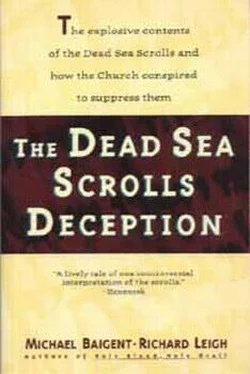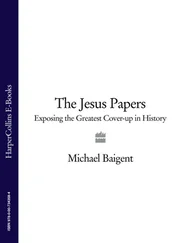The ‘Damascus Document’ also echoes the ‘Community Rule’ and the ‘War Scroll’ by speaking of a Messianic figure (or perhaps two such figures) who will come to ‘Damascus’ — a prophet or ‘Interpreter of the Law’ called ‘the Star’ and a prince of the line of David called ‘the Sceptre’. 19On five subsequent occasions in the text, there is a focus on a single figure, ‘the Messiah of Aaron and Israel’. 20
The significance of this Messiah figure will be explored later. For the moment, it is worth considering the implications of ‘Damascus’ as a designation for Qumran. To most Christians, of course, ‘Damascus’ is familiar from Chapter 9 of the Acts of the Apostles, where it is taken to denote the Romanised city in Syria, that country’s modern-day capital. It is on the road to Damascus that Saul of Tarsus, in one of the best-known and most crucial passages of the entire New Testament, undergoes his conversion into Paul. 21
According to Acts 9, Saul is a kind of inquisitor-cum-’enforcer’, dispatched by the high priest in the Temple of Jerusalem to suppress the community of heretical Jews — i.e. ‘early Christians’ — residing in Damascus. The priesthood are collaborators with the occupying Romans, and Saul is one of their instruments. In Jerusalem, he is already said to have participated actively in attacks on the ‘early Church’. Indeed, if Acts is to be believed, he is personally involved in the events surrounding the stoning to death of the individual identified as Stephen, acclaimed by later tradition as the first Christian martyr. He himself freely admits that he has persecuted his victims ‘to death’.
Prompted by his fanatical fervour, Saul then embarks for Damascus, to ferret out fugitive members of the ‘early Church’ established there. He is accompanied by a band of men, presumably armed; and he carries with him arrest warrants from the high priest in Jerusalem.
Syria, at the time, was not a part of Israel, but a separate Roman province, governed by a Roman legate, with neither an administrative nor a political connection with Palestine. How, then, could the high priest’s writ conceivably run there? The Roman Empire would hardly have sanctioned self-appointed ‘hit-squads’ moving from one territory to another within its domains, serving arrests, perpetrating assassinations and threatening the precarious stability of civic order. According to official policy, every religion was to be tolerated, provided it posed no challenge to secular authority or the social structure. A Jerusalem-based ‘hit-squad’ operating in Syria would have elicited some swift and fairly gruesome reprisals from the Roman administration — reprisals such as no high priest, whose position depended on Roman favour, would dare to incur. Given these circumstances, how could Saul of Tarsus, armed with warrants from the high priest, possibly have undertaken his punitive expedition to Damascus — if, that is, ‘Damascus’ is indeed taken to be the city in Syria?
If ‘Damascus’ is understood to be Qumran, however, Saul’s expedition suddenly makes perfect historical sense. Unlike Syria, Qumran did lie in territory where the high priest’s writ legitimately ran. It would have been entirely feasible for the high priest in Jerusalem to dispatch his ‘enforcers’ to extirpate heretical Jews at Qumran, a mere twenty miles away, near Jericho. Such action would have thoroughly conformed to Roman policy, which made a point of not meddling in purely internal affairs. Jews, in other words, were quite free to harry and persecute other Jews within their own domains, so long as such activities did not encroach on the Roman administration. And since the high priest was a Roman puppet, his efforts to extirpate rebellious co-religionists would have been all the more welcome.
This explanation, however, despite its historical plausibility, raises some extremely awkward questions. According to the consensus of the international team, the community at Qumran consisted of Judaic sectarians — the so-called ‘Essenes’, a pacifist ascetic sect having no connection either with early Christianity or with the ‘mainstream’ of Judaism at the time. Yet Saul, according to Acts, embarks for Damascus to persecute members of the ‘early Church’. Here, then, is a provocative challenge both to Christian tradition and to adherents of the consensus, who have studiously avoided looking at the matter altogether. Either members of the ‘early Church’ were sheltering with the Qumran community – or the ‘early Church’ and the Qumran community were one and the same. In either case, the ‘Damascus Document’ indicates that the Dead Sea Scrolls cannot be distanced from the origins of Christianity.
The ‘Habakkuk Commentary’
Found in Cave 1 at Qumran, the ‘Habakkuk Pesher’, or ‘Habakkuk Commentary’, represents perhaps the closest approximation, in the entire corpus of known Dead Sea Scrolls, to a chronicle of the community — or, at any rate, of certain major developments in its history. It focuses in particular on the same dispute cited by the ‘Damascus Document’. This dispute, verging on incipient schism, seems to have been a traumatic event in the life of the Qumran community. It figures not just in the ‘Damascus Document’ and the ‘Habakkuk Commentary’, but in four other Qumran texts as well; and there seem to be references to it in four further texts. 22
Like the ‘Damascus Document’, the ‘Habakkuk Commentary’ recounts how certain members of the community, under the iniquitous instigation of a figure identified as ‘the Liar’, secede, break the New Covenant and cease to adhere to the Law. This precipitates a conflict between them and the community’s leader, ‘the Teacher of Righteousness’. There is mention, too, of a villainous adversary known as ‘the Wicked Priest’. Adherents of the consensus have generally tended to regard ‘the Liar’ and ‘the Wicked Priest’ as two different sobriquets for the same individual. More recently, however, Eisenman has effectively demonstrated that ‘the Liar’ and ‘the Wicked Priest’ are two quite separate and distinct personages. 23He has made it clear that ‘the Liar’, unlike ‘the Wicked Priest’, emerges from within the Qumran community. Having been taken in by the community and accepted as a member in more or less good standing, he then defects. He is not just an adversary, therefore, but a traitor as well. In contrast, ‘the Wicked Priest’ is an outsider, a representative of the priestly establishment of the Temple. Although an adversary, he is not therefore a traitor. What makes him important for our purposes is the clue he provides to the dating of the events recounted in the ‘Habakkuk Commentary’. If ‘the Wicked Priest’ is a member of the Temple establishment, it means the Temple is still standing and the establishment intact. In other words, the activities of ‘the Wicked Priest’ pre-date the destruction of the Temple by Roman troops.
As in the ‘War Scroll’, but even more explicitly, there are references that can only be to imperial, not republican, Rome — to Rome, that is, in the 1st century AD. The ‘Habakkuk Commentary’, for example, alludes to a specific practice — victorious Roman troops making sacrificial offerings to their standards. Josephus provides written evidence for this practice at the time of the fall of the Temple in ad 70. 24And it is, in fact, a practice that would make no sense under the republic, when victorious troops would have offered sacrifices to their gods. Only with the creation of the empire, when the emperor himself was accorded the status of divinity, becoming the supreme god for his subjects, would his image, or token, or monogram, be emblazoned on the standards of his soldiers. The ‘Habakkuk Commentary’, therefore, like the ‘War Scroll’, the Temple Scroll’ and the ‘Damascus Document’, points specifically to the Herodian epoch.
Читать дальше












